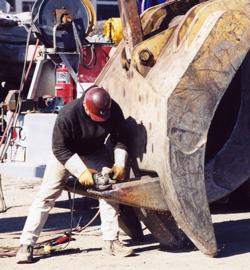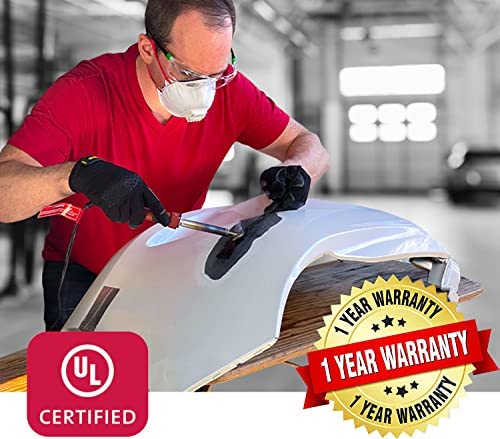Everything about Welding: Trick Insights Into Techniques and Ideal Practices for Success
Welding includes a selection of methods, each fit for particular products and applications. Recognizing these approaches, such as GMAW, SMAW, and TIG, is necessary for achieving ideal results. The right equipment and security techniques can not be overlooked. As prep work and fixing play vital roles in the welding process, mastering these components can substantially boost the high quality of the final item. What are the crucial factors that assure a successful weld?
Recognizing Various Welding Techniques
Welding strategies encompass a selection of techniques, each fit to certain applications and materials. Among the most common strategies are Gas Metal Arc Welding (GMAW), Shielded Steel Arc Welding (SMAW), and Tungsten Inert Gas Welding (TIG) GMAW, likewise called MIG welding, is preferred for its speed and convenience, making it suitable for slim products. SMAW, or stick welding, is preferred for its simplicity and effectiveness in outside environments, specifically with thicker metals. TIG welding provides accuracy and control, making it appropriate for complex work and non-ferrous metals (Montana Mobile Welding and Repair). Each technique has its special advantages and factors to consider, enabling welders to choose the very best technique based upon the project's demands, product kind, and wanted outcomes. Recognizing these techniques is important for successful welding
Essential Welding Devices and Devices
While numerous welding techniques call for certain skills, the best tools and devices are just as crucial for attaining quality results. Important welding devices consists of welding machines, which differ depending on the strategy-- such as MIG, TIG, or stick welding. Protective equipment, including aprons, handwear covers, and safety helmets, warranties safety and comfort throughout the process. Additionally, fixtures and clamps assist protect materials in position, making sure accuracy in welds. Consumables like welding rods, cord, and protecting gas are additionally vital elements that influence the quality of the weld. Additionally, tools such as grinders and cutters promote surface preparation and post-weld finishing, adding to a specialist end result. Investing in high-quality tools ultimately enhances the performance and efficiency of welding projects.
Safety Practices in Welding
Correct safety and security practices are essential in the welding industry to secure workers from potential risks. Welders need to wear suitable individual protective tools (PPE), consisting of headgears with appropriate shading, gloves, and flame-resistant clothes. Ample ventilation is essential to decrease exposure to hazardous fumes and gases created throughout the welding process. Additionally, employees must be learnt the appropriate handling of welding devices to avoid mishaps. Fire precaution, such as keeping combustible materials far from the welding location and having fire extinguishers readily available, are necessary. Routine inspections of tools and work spaces can aid recognize prospective dangers before they bring about mishaps. By sticking to these security techniques, welders can produce a much safer working environment and lessen threats connected with their trade.
Readying Products for Welding
Preparing materials for welding is a crucial action that substantially affects the quality and integrity of the last product (Montana Mobile Welding and Repair Belgrade Fabrication). Proper prep work entails cleansing the surface areas to get rid of pollutants such as dirt, oil, and rust, which can endanger the weld. Techniques such as grinding, fining sand, or using solvents are typically used to attain a tidy surface. Additionally, making sure that the materials fit with each other comfortably is necessary; gaps can result in weak welds. It's additionally important to think about the alignment and positioning of the components, as this will certainly influence the ease of welding and the last end result. Ultimately, choosing the proper filler material and ensuring compatibility with the base metals is important for achieving solid, durable welds
Tips for Getting High-Quality Welds
Accomplishing high-quality welds requires focus to detail and adherence to finest practices throughout the welding procedure. Appropriate joint prep work is necessary, making sure surfaces are clean and cost-free from contaminants. Picking the proper filler material and welding method based on the base metals is essential for suitable bonding. Keeping constant travel speed and angle while welding can stop issues and advertise harmony. Additionally, managing warm input is important; excessive warm can cause warping and damaged joints. If required, routinely examining the welds throughout the procedure allows for instant adjustments. Finally, using suitable post-weld treatments, such as cleansing and stress alleviation, can boost the toughness and stability of the weld, ultimately making sure a successful end result.
Fixing Common Welding Issues
Welding often offers difficulties that can influence the quality and honesty of the last item. Common issues such as porosity, inconsistent weld beads, and overheating can emerge, each calling for craftsman welder certain fixing strategies. Comprehending these problems is important for welders to enhance their abilities and achieve perfect outcomes.
Porosity Issues Discussed
Although porosity can often be ignored, it remains a vital issue in welding that can compromise the stability of a completed product. Porosity describes the visibility of small gas pockets within the weld bead, which can lead and damage the joint to premature failing. This trouble typically occurs from pollutants, dampness, or incorrect shielding gas coverage throughout the welding process. To reduce porosity, welders must confirm that the base products are completely dry and tidy, make use of appropriate protecting gases, and keep regular welding specifications. Regularly checking the equipment and he has a good point setting can additionally help identify possible concerns before they show up in the weld. Dealing with porosity successfully is necessary for accomplishing strong, durable welds that fulfill top quality criteria.

Irregular Weld Beads
Inconsistent weld beads can greatly impact the high quality and stamina of a completed product. Numerous elements add to this problem, consisting of improper traveling speed, inaccurate amperage setups, and inconsistent electrode angles. When the welder relocates also promptly, a grain may appear narrow and lack penetration, while moving also gradually can cause too much buildup. Additionally, making use of the incorrect amperage can result in either damaging or too much spatter, both of which concession weld integrity. The welder's technique, such as inconsistent torch motion, can likewise bring about uneven bead appearance. To minimize these troubles, welders should concentrate on maintaining stable, controlled motions and making sure proper devices setups to accomplish harmony in their welds. Consistency is vital to achieving reputable and strong welds.
Getting Too Hot and Bending Issues
Extreme warm during the welding process can cause considerable getting too hot and buckling concerns, influencing the structural integrity of the work surface. These issues often manifest as distortion, which can compromise positioning and fit-up, making more assembly challenging. Aspects adding to overheating include the selection of welding criteria, such as voltage and travel speed, in addition to the sort of material being welded. To minimize these problems, welders need to keep consistent travel rate and appropriate heat input while checking the work Full Report surface temperature. Additionally, preheating or post-weld warmth treatment can help minimize tensions brought on by rapid air conditioning - Belgrade. Regular inspection and adherence to finest practices are necessary in protecting against getting too hot and ensuring the long life and reliability of welded frameworks
Frequently Asked Questions
What Are the Career Opportunities in the Welding Market?
The welding industry supplies diverse profession opportunities, including settings as welders, engineers, teachers, and assessors. Experts can operate in production, building and construction, aerospace, and vehicle sectors, taking advantage of solid demand and competitive incomes in various duties.
Just How Can I Enhance My Welding Speed Without Giving Up Top Quality?
To enhance welding speed without giving up top quality, one need to exercise effective methods, preserve devices, maximize settings, and enhance hand-eye control. Regular training and seeking feedback can likewise considerably add to attaining faster, top notch welds.
What Accreditations Are Readily Available for Welders?
Numerous certifications exist for welders, consisting of those from the American Welding Society (AWS), the National Center for Building Education and Study (NCCER), and different industry-specific organizations. These credentials improve employability and demonstrate skill efficiency.
How Does Welding Affect the Residences of Metals?
Welding influences the residential or commercial properties of metals by altering their microstructure, which can cause adjustments in toughness, solidity, and ductility. Warm input and cooling prices during the procedure greatly impact these product characteristics.
Can I Weld Dissimilar Metals Together?
